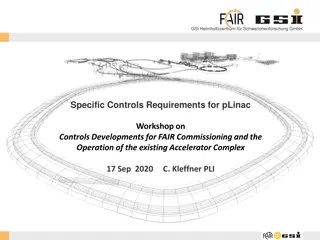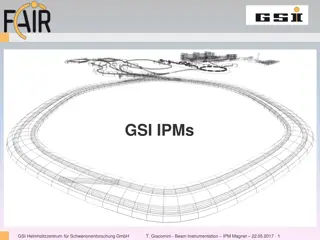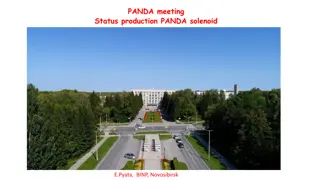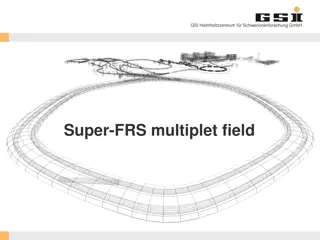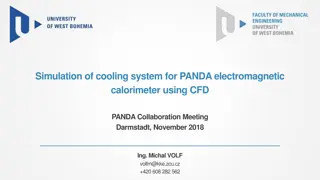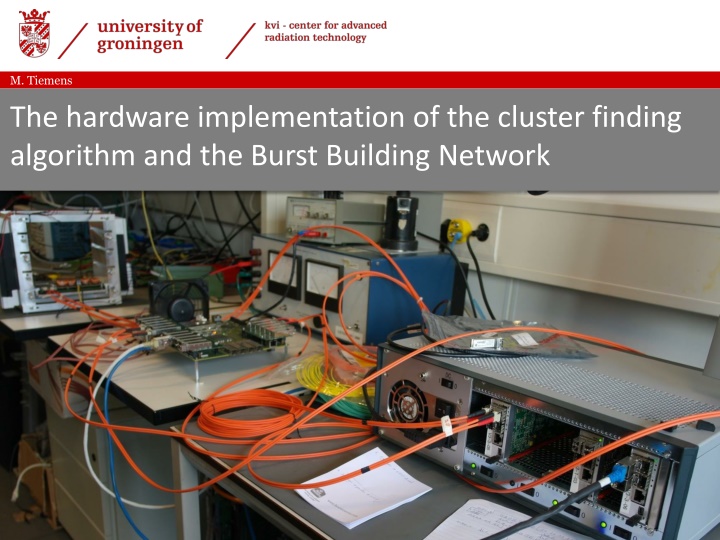
Hardware Implementation of Cluster Finding Algorithm by M. Tiemens
Explore M. Tiemens' hardware implementation of a cluster finding algorithm and the Burst Building Network. The distributed cluster finding process, VHDL implementation test setup, comparison between PandaRoot and VHDL, data structures, edge detection, data flow implications, and data collection rates are all discussed in detail.
Download Presentation

Please find below an Image/Link to download the presentation.
The content on the website is provided AS IS for your information and personal use only. It may not be sold, licensed, or shared on other websites without obtaining consent from the author. If you encounter any issues during the download, it is possible that the publisher has removed the file from their server.
You are allowed to download the files provided on this website for personal or commercial use, subject to the condition that they are used lawfully. All files are the property of their respective owners.
The content on the website is provided AS IS for your information and personal use only. It may not be sold, licensed, or shared on other websites without obtaining consent from the author.
E N D
Presentation Transcript
M. Tiemens The hardware implementation of the cluster finding algorithm and the Burst Building Network
M. Tiemens | 2 Recap Map EMC Data Concentrator
M. Tiemens | 3 Distributed Cluster Finding ? ?0 ? ?0 Form preclusters: 1 ?? ? ? ? 5000 events @200 kHz Merge preclusters: (if needed) 2 (Set properties of completed clusters) 3
M. Tiemens | 4 Distributed Cluster Finding ? Relative nr of events reconstructed: ?0 Default: 29.4% ? Online: 28.7% ?0 23.9% Distributed: ?? ? ? ? CPU processing time (relative to Default): 5000 events @200 kHz Default: 1 Online: 1.19 Distributed: 0.93 (0.05 + 0.88)
M. Tiemens | 5 VHDL Implementation Test Setup Kintex 7 Test Board Compute Node SFP SFP DC SFP SFP DC SFP SFP DC SFP SFP DC Gb Ethernet Data (4 DC s) PC USB
M. Tiemens | 6 Comparison Between PandaRoot and VHDL Kintex 7 Test Board Compute Node SFP SFP DC SFP SFP DC SFP SFP DC SFP SFP DC Gb Ethernet Data (4 DC s) PC USB Mapped X-position
M. Tiemens | 7 Data Structure 64-bit words PRECLUSTER1 | X | Y | D | t | NR_OF_HITS X, Y : Position in 2D Map D : Diameter of Precluster t : Time E : Energy HIT1 | t | E | ch. nr HIT2 | t | E | ch. nr CLUSTER1 | x | y | z | t | E | NR_OF_HITS HIT1 | t | E | ch. nr HIT2 | t | E | ch. nr
M. Tiemens | 8 What if a Photon Hits the Edge? EDGE Detection: Energy-weighted position is close to edge of map Options: Discard these clusters 1 Apply correction factor to E 2 Use complicated neighbour relation to edge of other map 3
M. Tiemens | 9 All right, so what does this all mean for the data flow, and the processing thereof?
M. Tiemens | 10 Data Collection EMC BwEndcap + Barrel SADCs <10 kHz Rate /device (Gbps) Total rate (Gbps) Rate/device (Gbps) Total rate (Gbps) 260.4 # # FwEndcap 572 0.05 28.6 SADCs 300 kHz 217 1.2 SADCs >10, <50 kHz 512 0.27 138.24 SADCs >50 kHz 112 0.6 67.2 Total 1196 234.04 217 260.4
M. Tiemens | 11 BwEndcap Barrel FwEndcap 1196 digitisers Total rate: 234 Gbps 217 digitisers Total rate: 260 Gbps 0101 0101 0101 0101 0101 BwEndcap + Barrel SADCs <10 kHz Rate /device (Gbps) Total rate (Gbps) Rate/device (Gbps) Total rate (Gbps) 260.4 3 1 # # FwEndcap 16 inputs 572 0.05 28.6 SADCs 300 kHz 217 1.2 SADCs >10, <50 kHz 512 0.27 138.24 Assuming worst case where each hit SADCs >50 kHz 112 0.6 67.2 25 Data Concentrators Total rate: 468 Gbps 14 Data Concentrators Total rate: 520 Gbps Total 1196 234.04 becomes a cluster 217 260.4
M. Tiemens | 12 Output Produced by Data Concentrators (DCs) 14 Data Concentrators Total rate: 520 Gbps 25 Data Concentrators Total rate: 468 Gbps 50 optical links 42 optical links 1196 digitisers Total rate: 234 Gbps @10 Gbps 217 digitisers Total rate: 260 Gbps @12 Gbps 0101 0101 0101 0101 0101 3 1 Now what?
M. Tiemens | 13 Processing the DC Output 14 Data Concentrators Total rate: 520 Gbps 3 Options for the BBN*: 25 Data Concentrators Total rate: 468 Gbps Throw everything into one big data collection network, which may or may not do more advanced processing (at least collect and sort data). 50 optical links @10 Gbps 42 optical links @12 Gbps 1 2 Do some data merging, then do 1. Now what? 3 Collect everything in a switch, and let one big FPGA board do the rest. *Burst Building Network, PANDA s data collection and processing network
M. Tiemens | 14 Processing the DC Output 1 14 Data Concentrators Total rate: 520 Gbps 3 Options for the BBN*: 25 Data Concentrators Total rate: 468 Gbps Throw everything into one big data collection network, which may or may not do more advanced processing (at least collect and sort data). 50 optical links @10 Gbps 42 optical links @12 Gbps 1 Switch 2 Do some data merging, then do 1. 63 optical links @16 Gbps Smart Network + Merge preclusters + Kick low-E clusters* 3 Collect everything in a switch, and let one big FPGA board do the rest. Sort 1 3 2 Repeat until entire EMC covered
M. Tiemens | 15 1. Sort Topology of the Network 1 2. Merge Preclusters 3. Kick Low-E Clusters* 63 optical links @16 Gbps 508 Gbps (if 1+2+3) 1 Tbps (if 0 or 1) 32 Optical links (if 1+2+3) 63 Optical links (if 0 or 1)
M. Tiemens | 16 Topology of the Network 1 Procedure (after sorting): Network 1. Make timebunches: 2. Send 1stn timebunches to n FPGAs on 1stCN 32 links /63 links 3. Send 2ndn timebunches to n FPGAs on 2ndCN 4. Etc until mth CN, then send to 1stCN again and repeat from 2. Compute Nodes
M. Tiemens | 17 Topology of the Network Processing the DC Output Procedure (after sorting): 3 Options for the BBN: Network Throw everything into one big data collection network, which may or may not do more advanced processing (at least collect and sort data). 1. Make timebunches: 1 2. Send 1stn timebunches to n FPGAs on 1stCN 32 links /63 links Do some data merging, then do 1. 2 3. Send 2ndn timebunches to n FPGAs on 2ndCN 4. Etc until mth CN, then send to 1stCN again and repeat from 2. Collect everything in a switch, and let one big FPGA board do the rest. 3 Compute Nodes
M. Tiemens | 18 Processing the DC Output 2 14 Data Concentrators Total rate: 520 Gbps 3 Options for the BBN: 25 Data Concentrators Total rate: 468 Gbps Throw everything into one big data collection network, which may or may not do more advanced processing (at least collect and sort data). @10 Gbps device 2 per 50 optical links 3 per device 42 optical links @12 Gbps 1 Combine data from 4 DCs Combine data from 3 DCs Do some data merging, then do 1. 8 inputs 9 inputs 2 8 outputs 7 outputs 3 Collect everything in a switch, and let one big FPGA board do the rest. 7 Network DCs Total rate: 293 Gbps @16 Gbps 19 optical links 21 optical links @16 Gbps 5 Network DCs Total rate: 325 Gbps (Uncombined: 63 links @988 Gbps)
M. Tiemens | 19 Processing the DC Output 14 Data Concentrators Total rate: 520 Gbps 3 Options for the BBN: 25 Data Concentrators Total rate: 468 Gbps Throw everything into one big data collection network, which may or may 2 per device not do more advanced processing (at least collect and sort data). 50 optical links @10 Gbps 3 per device 42 optical links @12 Gbps 1 Combine data from 4 DCs Combine data from 3 DCs 8 inputs 9 inputs 2 Do some data merging, then do 1. 8 outputs 7 outputs 3 Collect everything in a switch, and let one big FPGA board do the rest. 7 Network DCs Total rate: 293 Gbps 19 optical links @16 Gbps 21 optical links @16 Gbps 5 Network DCs Total rate: 325 Gbps
M. Tiemens | 20 Processing the DC Output 3 14 Data Concentrators Total rate: 520 Gbps 3 Options for the BBN: 25 Data Concentrators Total rate: 468 Gbps Throw everything into one big data collection network, which may or may not do more advanced processing (at least collect and sort data). @10 Gbps 50 optical links 42 optical links @12 Gbps 1 32 Gbps Switch 2 Do some data merging, then do 1. 31 optical links @32 Gbps Collect everything in a switch, and let one big FPGA board do the rest. VU31P: Overflow if VU35P occupied 3 Xilinx UltraScale+ VU35P (64x 32Gbps transceivers) 16 optical links @32 Gbps
M. Tiemens | 21 Processing the DC Output 3 14 Data Concentrators Total rate: 520 Gbps 25 Data Concentrators Total rate: 468 Gbps 50 optical links @10 Gbps 42 optical links @12 Gbps 32 Gbps Switch 31 optical links @32 Gbps VU31P: Overflow if VU35P occupied 32 Gbps Switch Xilinx UltraScale+ VU35P (64x 32Gbps transceivers) 32 Optical links @16 Gbps 16 optical links @32 Gbps
M. Tiemens | 22 Summary and Outlook Hardware implementation of clustering has been made: 1 Results agree with PandaRoot sim. a Check with FPGA specifications to explore possibilities. b 2 Several options for the BBN are being explored. Recommendation: Use Option 3 (big FPGA board). 1 If not possible (see 1b), use Option 2 (do data merging, then feed to BBN). 2
M. Tiemens | 23 Open Question to Collaboration: What do other subsystems require of the BBN?




